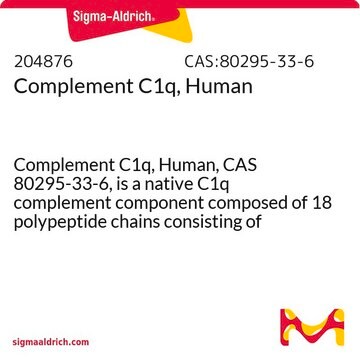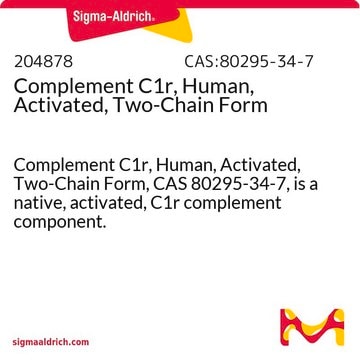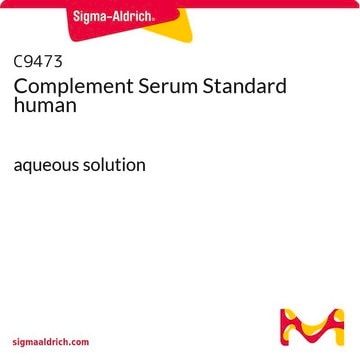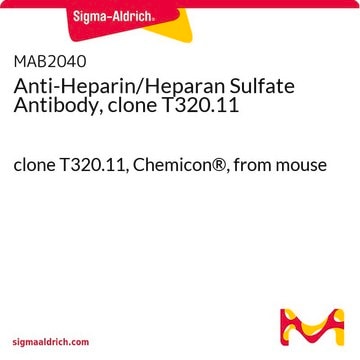204873
Complement C1, Human
Complement C1, Human Native, is the first component of the classical complement pathway. It is a calcium-dependent complex of C1q, C1r, and C1s subcomponents.
Anmeldenzur Ansicht organisationsspezifischer und vertraglich vereinbarter Preise
Alle Fotos(1)
About This Item
UNSPSC-Code:
12352202
NACRES:
NA.25
Empfohlene Produkte
Qualitätsniveau
Form
liquid
Hersteller/Markenname
Calbiochem®
Lagerbedingungen
OK to freeze
avoid repeated freeze/thaw cycles
Versandbedingung
wet ice
Lagertemp.
−70°C
Allgemeine Beschreibung
Native, human C1 complement component. C1 is the first component of the classical complement pathway. It is a calcium dependent complex of C1q, C1r, and C1s subcomponents which are present in the C1 complex at molar ratios of 1:2:2 respectively. Binding of C1 to classical pathway activators results in the conversion of the proenzyme C1s subcomponent to an active C1s enzyme. C1s enzyme cleaves both C4 and C2, resulting in formation of the C3 cleaving enzyme, C4b, C2a, of the classical complement pathway. C1 concentration is based on functional activity measurements relative to a normal serum standard pool.
Native, human C1 complement component. C1 is the first component of the classical complement pathway. It is a calcium-dependent complex of C1q, C1r, and C1s subcomponents which are present in the C1 complex at molar ratios of 1:2:2, respectively. Binding of C1 to classical pathway activators results in the conversion of the proenzyme C1s subcomponent to an active C1s enzyme. C1s enzyme cleaves both C4 and C2 resulting in formation of the C3 cleaving enzyme, C4b, C2a, of the classical complement pathway. C1 concentration is based on functional activity measurements relative to a normal serum standard pool.
Verpackung
Please refer to vial label for lot-specific concentration.
Warnhinweis
Toxicity: Standard Handling (A)
Physikalische Form
In 300 mM NaCl, 50 mM sodium acetate, 50 mM EACA, 25 µM NPGB, 10 mM benzamidine, 10 mM EDTA, 40% glycerol, pH 5.5.
Sonstige Hinweise
Cooper, N.R. 1985. Adv. Immunol. 37, 151.
Ziccardi, R.J. and Cooper, N.R. 1977. J. Immunol. 118, 2047.
Ziccardi, R.J. and Cooper, N.R. 1977. J. Immunol. 118, 2047.
Rechtliche Hinweise
CALBIOCHEM is a registered trademark of Merck KGaA, Darmstadt, Germany
Lagerklassenschlüssel
10 - Combustible liquids
WGK
WGK 1
Flammpunkt (°F)
Not applicable
Flammpunkt (°C)
Not applicable
Analysenzertifikate (COA)
Suchen Sie nach Analysenzertifikate (COA), indem Sie die Lot-/Chargennummer des Produkts eingeben. Lot- und Chargennummern sind auf dem Produktetikett hinter den Wörtern ‘Lot’ oder ‘Batch’ (Lot oder Charge) zu finden.
Besitzen Sie dieses Produkt bereits?
In der Dokumentenbibliothek finden Sie die Dokumentation zu den Produkten, die Sie kürzlich erworben haben.
Yitian Cai et al.
Journal of immunology (Baltimore, Md. : 1950), 199(12), 3981-3990 (2017-10-27)
Anti-nuclear autoantibodies, which frequently target the nucleoli, are pathogenic hallmarks of systemic lupus erythematosus (SLE). Although the causes of these Abs remain broad and ill-defined, a genetic deficiency in C1 complex (C1qC1r2C1s2) or C4 is able to induce these Abs.
Yitian Cai et al.
The Journal of biological chemistry, 290(37), 22570-22580 (2015-08-02)
In infection, complement C1q recognizes pathogen-congregated antibodies and elicits complement activation. Among endogenous ligands, C1q binds to DNA and apoptotic cells, but whether C1q binds to nuclear DNA in apoptotic cells remains to be investigated. With UV irradiation-induced apoptosis, C1q
Réka Á Kovács et al.
Frontiers in immunology, 11, 599771-599771 (2021-02-26)
Elements of the immune system particularly that of innate immunity, play important roles beyond their traditional tasks in host defense, including manifold roles in the nervous system. Complement-mediated synaptic pruning is essential in the developing and healthy functioning brain and
Ahsan Habib et al.
Cell transplantation, 27(4), 666-676 (2018-06-07)
Alzheimer's Disease (AD) is the leading cause of dementia in the elderly. In healthy individuals, amyloid precursor protein (APP) is cleaved by α-secretase, generating soluble α-amyloid precursor protein (sAPPα), which contributes neuroprotective functions in the neuronal environment. In contrast, in
Unser Team von Wissenschaftlern verfügt über Erfahrung in allen Forschungsbereichen einschließlich Life Science, Materialwissenschaften, chemischer Synthese, Chromatographie, Analytik und vielen mehr..
Setzen Sie sich mit dem technischen Dienst in Verbindung.


